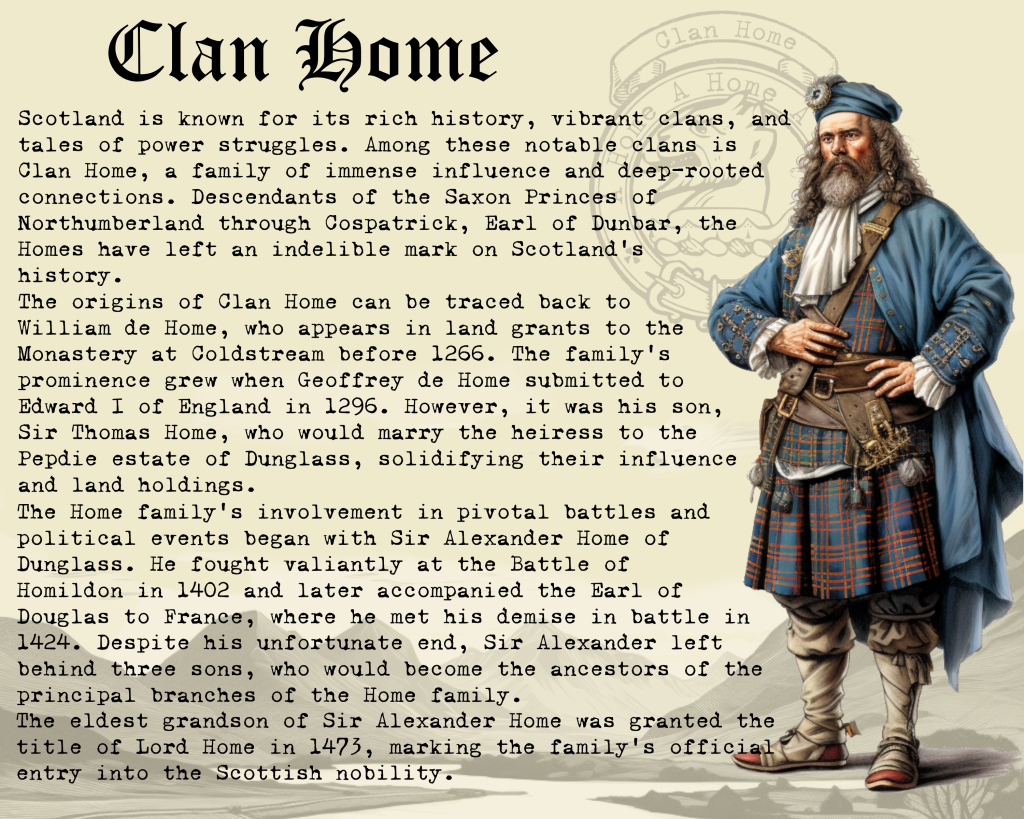Home Clan
|
|
CREST: Dexter, on a cap of maintenance Proper, a lion’s head erased Argent MOTTO: A Home • A Home • A Home TRANSLATION: N/A VARIATIONS: Hume |
 Scotland is known for its rich history, vibrant clans, and tales of power struggles. Among these notable clans is Clan Home, a family of immense influence and deep-rooted connections. Descendants of the Saxon Princes of Northumberland through Cospatrick, Earl of Dunbar, the Homes have left an indelible mark on Scotland’s history. Scotland is known for its rich history, vibrant clans, and tales of power struggles. Among these notable clans is Clan Home, a family of immense influence and deep-rooted connections. Descendants of the Saxon Princes of Northumberland through Cospatrick, Earl of Dunbar, the Homes have left an indelible mark on Scotland’s history.
The origins of Clan Home can be traced back to William de Home, who appears in land grants to the Monastery at Coldstream before 1266. The family’s prominence grew when Geoffrey de Home submitted to Edward I of England in 1296. However, it was his son, Sir Thomas Home, who would marry the heiress to the Pepdie estate of Dunglass, solidifying their influence and land holdings. The Home family’s involvement in pivotal battles and political events began with Sir Alexander Home of Dunglass. He fought valiantly at the Battle of Homildon in 1402 and later accompanied the Earl of Douglas to France, where he met his demise in battle in 1424. Despite his unfortunate end, Sir Alexander left behind three sons, who would become the ancestors of the principal branches of the Home family. The eldest grandson of Sir Alexander Home was granted the title of Lord Home in 1473, marking the family’s official entry into the Scottish nobility. This title brought them further prominence and opportunities for political involvement. For instance, Lord Home participated in the rebellion against James III, which led to the king’s demise. However, the Home family’s fortunes fluctuated, and Lord Home and his brother were executed for treason in 1516. Despite this setback, the title and estates were eventually restored to George Home, another brother, who continued the family’s legacy by leading his Border spearmen against the English. Tragically, George Home met his end on the eve of the Battle of Pinkie in 1547, yet his son Alexander, the fifth Lord Home, successfully recaptured the Homelands from English invaders in 1549. The Homes played an active role in religious and political shifts during the reign of Mary, Queen of Scots. As allegiances changed, so did the Home family’s stance. Lord Home initially supported Mary’s marriage to Bothwell but later fought against her at the Battle of Langside. Alexander, the sixth Lord Home, remained unwavering in his devotion to James VI, earning favor and recognition from the king. In 1603, when James VI traveled to England to ascend the English throne as James I, Lord Home accompanied him, cementing his loyalty and favor. In recognition of his unwavering support, Lord Home was elevated to the title of Earl of Home in March 1605. The third Earl of Home further solidified the family’s allegiance by supporting Charles I during the tumultuous period leading up to the English Civil War. However, the Home family’s allegiances continued to shift during the Jacobite risings. The seventh Earl of Home was imprisoned during the 1715 rising, while his brother, James Home of Ayton, had his estates confiscated. During the 1745 uprising led by the ‘Young Pretender,’ the eighth Earl joined the government forces and fought at the Battle of Preston. Notably, the Home family has produced notable figures outside the realm of politics and warfare. Henry Home, known as Lord Kames, was a distinguished lawyer and author of influential works on Scots Law in the eighteenth century. Another celebrated figure, David Hume, emerged as one of the most highly regarded British philosophers of his time. |
|
Citations:
|
|

Purchase @ Redbubble
Purchase @ Amazon.com
Purchase @ Amazon.co.uk

